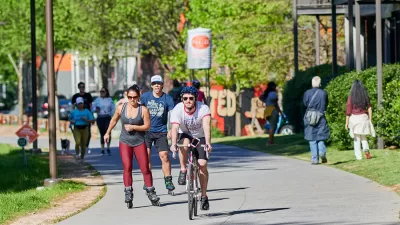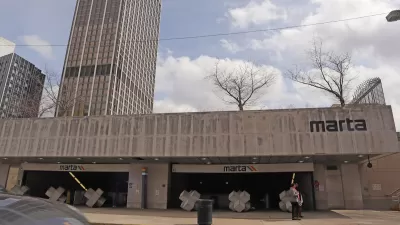The Eastside Trail of the Atlanta BeltLine is immensely popular. With funding still in question and construction behind schedule on some of the transit that would integrate with the BeltLine, one writer re-examines the trail's vast potential.
Rebecca Burns details the vast potential of the Atlanta Beltline, which is already delivering amazing experiences—and development—to the city.
"This year the Eastside Trail will attract a million visitors, the same number who come to the Georgia Aquarium. On weekends, the trail is so crowded that local media outlets have published etiquette tips and user guides. People drive in from the suburbs to walk the Eastside Trail. You can order a fancy $13 BeltLine Burger or rent a two-wheeler from Atlanta Beltline Bicycle. 'BeltLine' is plastered across for-sale signs in the yards of aging bungalows and on banners promoting new apartment buildings. Over the past six months, townhouses sprouted like mushrooms along the Eastside Trail."
But the BeltLine has more to give, if it's an incomplete project, and its benefits might be felt in places other than the BeltLine itself. Writes Burns: "true transformation will not be measured in residential units and miles of paved trail. The real measure of the BeltLine's success will be whether it can make a difference in Atlanta's car-dependent transportation system — and whether it can connect neighborhoods that have been separated by race and class since the days of Reconstruction."
And the BeltLine's true potential to transform the city, according to Burns, comes from the trails integration with transportation: "What makes the BeltLine potentially so transformative is that, unlike the hundreds of 'rails to trails' projects nationwide, it is designed as a transportation project. It will include light rail lines with 45 neighborhood stops and connections to the city's MARTA rail system and the Atlanta Streetcar."
Burns's article also includes more information about the current status of the project and renderings of the proposed development of the Southside and Westside trails.
FULL STORY: Can Atlanta Go All In on the BeltLine?

Planetizen Federal Action Tracker
A weekly monitor of how Trump’s orders and actions are impacting planners and planning in America.

Chicago’s Ghost Rails
Just beneath the surface of the modern city lie the remnants of its expansive early 20th-century streetcar system.

San Antonio and Austin are Fusing Into one Massive Megaregion
The region spanning the two central Texas cities is growing fast, posing challenges for local infrastructure and water supplies.

Since Zion's Shuttles Went Electric “The Smog is Gone”
Visitors to Zion National Park can enjoy the canyon via the nation’s first fully electric park shuttle system.

Trump Distributing DOT Safety Funds at 1/10 Rate of Biden
Funds for Safe Streets and other transportation safety and equity programs are being held up by administrative reviews and conflicts with the Trump administration’s priorities.

German Cities Subsidize Taxis for Women Amid Wave of Violence
Free or low-cost taxi rides can help women navigate cities more safely, but critics say the programs don't address the root causes of violence against women.
Urban Design for Planners 1: Software Tools
This six-course series explores essential urban design concepts using open source software and equips planners with the tools they need to participate fully in the urban design process.
Planning for Universal Design
Learn the tools for implementing Universal Design in planning regulations.
planning NEXT
Appalachian Highlands Housing Partners
Mpact (founded as Rail~Volution)
City of Camden Redevelopment Agency
City of Astoria
City of Portland
City of Laramie





























